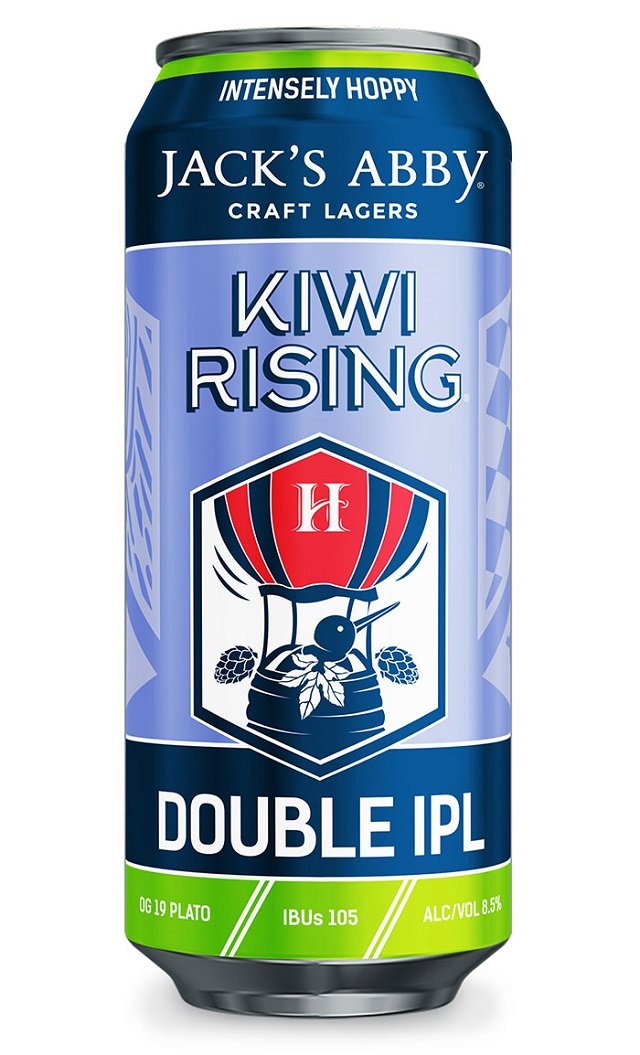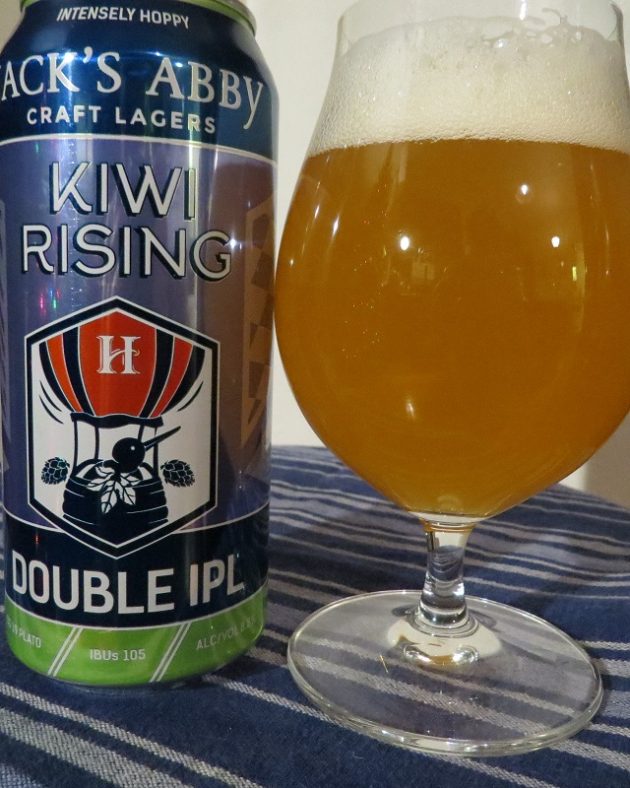
I didn’t intend to turn over a new leaf with my first review of the new year, but this week’s beer represents a few firsts for the “Birds and Booze” beat here at 10,000 Birds. This is the first drink I’ve reviewed featuring a bird not yet on my life list – and it’s not one I’m counting on adding any time soon. It’s also the first drink featuring a non-North American species (I’ll admit there’s a bias in my selections that’s largely dictated by geography). Lastly, this is the first appearance of a flightless bird in my weekly reviews, though this week’s plucky avian mascot is depicted getting airborne in the hop-laden basket of a hot-air balloon.
Kiwi Rising is a double India pale lager by Jack’s Abby Craft Lagers of Framingham, Massachusetts. I must admit that Jack’s Abby is one of my favorite breweries for its devotion to cool-fermented lager brewing in a craft beer industry dominated by warm-fermented ale production. In addition to brewing excellent examples of traditional European lager styles like Pilsner and Oktoberfest, Jack’s Abby plays with experimental flavors not always associated with these Old World classics, turning out lagers that are soured, made with fruit, or boasting enough hops to rival any double IPA.
Kiwi Rising is also the first beer I’ve reviewed that explicitly states that no birds – namely those of the Kiwi family (Apterygidae) – were harmed in its production – a disclaimer the brewery also extends to the kiwifruit (which is also known as the Chinese gooseberry, making it, to my knowledge, the only fruit named for two birds – and two very different birds at that). Unlike the bird, the fruit known as the kiwi isn’t native to New Zealand, but received that appellation in a marketing ploy by Kiwi kiwi growers – or if you prefer, New Zealander Chinese gooseberry farmers – to associate the fleshy, bright green fruit with Down Under agriculture.
What Kiwi Rising is named for is its use of the New Zealand harvests of another nonnative crop, the common hop. Though hops are used by brewers all over the world, traditional production is mostly restricted to a “hop belt” around the 48th parallel north, a circle of latitude that runs through the famed hop regions of Germany and the Pacific Northwest of the United States. With its similarly moist and temperate climate in the Southern Hemisphere, New Zealand has become the undisputed leader in antipodean hop production. Owing to its geographic isolation, New Zealand hop cultivation is free of the pests and diseases that commonly plague northern hopyards, allowing growers to concentrate on developing new flavors, rather than worrying so much about selecting strains for horticultural resistance. As a result, New Zealand hops are known for offering especially bright, fruity, citrusy, even savory flavors, and have become much sought-after by craft brewers, especially in the last few years.
Heavily-hopped lagers have yet to achieve the ubiquity of their India Pale Ale cousins, but brewers have begun applying the entire arsenal of extreme hopping techniques developed in craft ale brewing to cold-fermented lagers. They’ve even adopted a similarly pithy three-letter designation for these hoppy lagers, commandeering the “India pale” from IPA and awkwardly grafting it to “lager” to produce “IPL”, an appelation that’s best left abbreviated, lest its glaring ahistoricism be revealed.

Jack’s Abby calls Kiwi Rising a double IPL, so one would logically assume it’s even stronger than hoppier than an average IPL (though somewhat illogically, not exactly twice as much). Still, at 8.5% alcohol by volume and with a hoppiness measured at 105 International Bitterness Units (IBUs), this is a formidable drink by any standard. A golden, marigold yellow beer with a fine, lacy, off-white head, Kiwi Rising is surprisingly hazy for a cold-conditioned lager, which are generally known for their clarity. Jack’s Abby doesn’t specify which New Zealand hop strains it used in Kiwi Rising, but it sure used a lot: infusing every barrel (31 U.S. gallons) with four pounds of hops used in the boil, in the hopback, and in dry-hopping. The result is an intense and complex hop bouquet recalling tropical fruits like mango, passionfruit, and pineapple, softer cantaloupe and kiwifruit aromas, resiny notes of pine and orange peel, and a bright, floral overlay of lime. The palate is intensely citrusy, with an invigorating hop bitterness backed by a sweet and simple malt profile – a bit like nibbling on animal crackers with a mouthful of marmalade. The long finish is equally hoppy and full of sunny, grapefruit flavor.
Kiwi Rising is a seasonal release that comes out in September, and as with any beer that showcases hops over malt, it’s best enjoyed as fresh as possible. But I’m still finding it on the shelves, and – probably due to its durable packaging in 16-ounce “tall boy” cans – it tasted just as good this week as when I first had it a few months ago. And if you can’t find last year’s edition, it’s certainly worth looking forward to the 2018 release of Kiwi Rising.
Happy drinking and good birding!
________________________________________________
Jack’s Abby Craft Lagers: Kiwi Rising Double IPL
![]()
![]()
![]()
![]()
![]()
Four out of five feathers (Excellent)













Leave a Comment